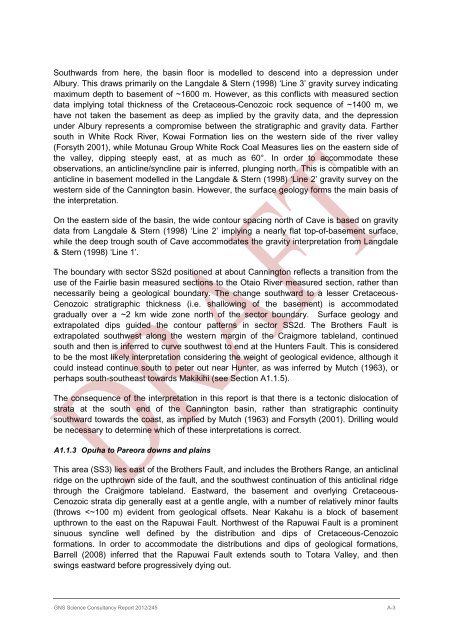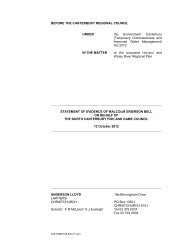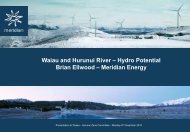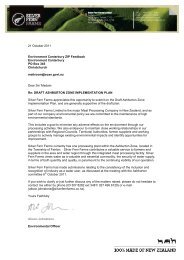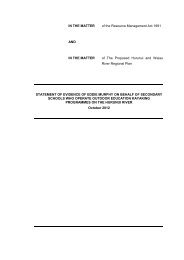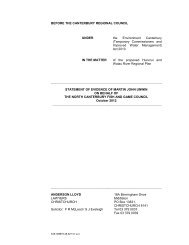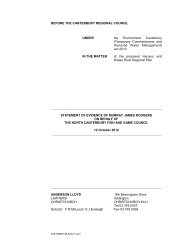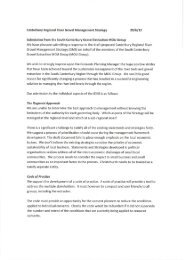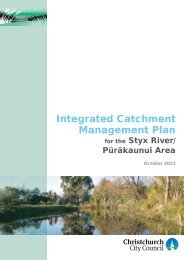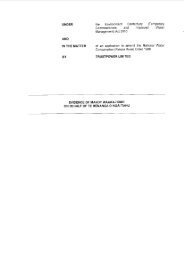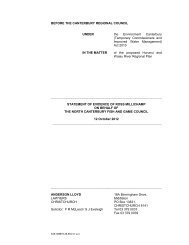Geological contours for groundwater modelling, South Canterbury
Geological contours for groundwater modelling, South Canterbury
Geological contours for groundwater modelling, South Canterbury
Create successful ePaper yourself
Turn your PDF publications into a flip-book with our unique Google optimized e-Paper software.
<strong>South</strong>wards from here, the basin floor is modelled to descend into a depression underAlbury. This draws primarily on the Langdale & Stern (1998) ‘Line 3’ gravity survey indicatingmaximum depth to basement of ~1600 m. However, as this conflicts with measured sectiondata implying total thickness of the Cretaceous-Cenozoic rock sequence of ~1400 m, wehave not taken the basement as deep as implied by the gravity data, and the depressionunder Albury represents a compromise between the stratigraphic and gravity data. Farthersouth in White Rock River, Kowai Formation lies on the western side of the river valley(Forsyth 2001), while Motunau Group White Rock Coal Measures lies on the eastern side ofthe valley, dipping steeply east, at as much as 60°. In order to accommodate theseobservations, an anticline/syncline pair is inferred, plunging north. This is compatible with ananticline in basement modelled in the Langdale & Stern (1998) ‘Line 2’ gravity survey on thewestern side of the Cannington basin. However, the surface geology <strong>for</strong>ms the main basis ofthe interpretation.On the eastern side of the basin, the wide contour spacing north of Cave is based on gravitydata from Langdale & Stern (1998) ‘Line 2’ implying a nearly flat top-of-basement surface,while the deep trough south of Cave accommodates the gravity interpretation from Langdale& Stern (1998) ‘Line 1’.The boundary with sector SS2d positioned at about Cannington reflects a transition from theuse of the Fairlie basin measured sections to the Otaio River measured section, rather thannecessarily being a geological boundary. The change southward to a lesser Cretaceous-Cenozoic stratigraphic thickness (i.e. shallowing of the basement) is accommodatedgradually over a ~2 km wide zone north of the sector boundary. Surface geology andextrapolated dips guided the contour patterns in sector SS2d. The Brothers Fault isextrapolated southwest along the western margin of the Craigmore tableland, continuedsouth and then is inferred to curve southwest to end at the Hunters Fault. This is consideredto be the most likely interpretation considering the weight of geological evidence, although itcould instead continue south to peter out near Hunter, as was inferred by Mutch (1963), orperhaps south-southeast towards Makikihi (see Section A1.1.5).The consequence of the interpretation in this report is that there is a tectonic dislocation ofstrata at the south end of the Cannington basin, rather than stratigraphic continuitysouthward towards the coast, as implied by Mutch (1963) and Forsyth (2001). Drilling wouldbe necessary to determine which of these interpretations is correct.A1.1.3 Opuha to Pareora downs and plainsThis area (SS3) lies east of the Brothers Fault, and includes the Brothers Range, an anticlinalridge on the upthrown side of the fault, and the southwest continuation of this anticlinal ridgethrough the Craigmore tableland. Eastward, the basement and overlying Cretaceous-Cenozoic strata dip generally east at a gentle angle, with a number of relatively minor faults(throws


